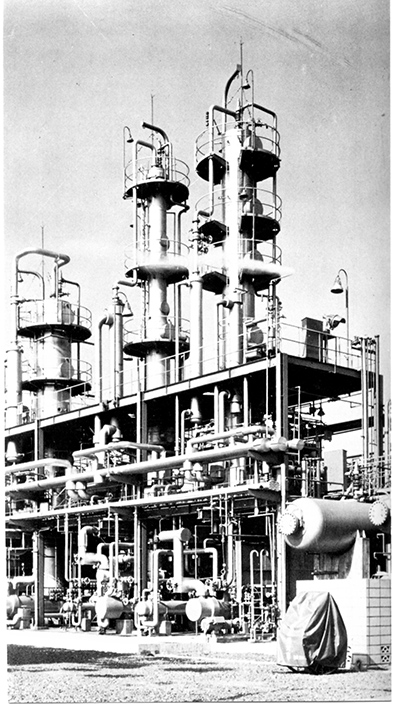With the establishment of integrated production from raw material, the Cashmilon business structure was strengthened. It solidified our position as the leader in acrylic fiber, but I still wasn’t satisfied. We couldn’t expect significant growth for regenerated fibers such as viscose rayon and Bemberg, so we had to find the next big thing after Cashmilon.
The question was what kind of businesses to start. My basic idea was to further reinforce our position in synthetic fibers, while also going into fields other than fibers to gain overall strength.
We held study sessions about new projects with members of the research office in charge of long-term strategy. I gathered young people who had been with the company for only a few years, feeling that they could come up with fresh ideas without preconceptions.
They worked energetically, thoroughly examining business prospects in fibers and other fields, as well as the prospects for Asahi Kasei to enter.
This lasted for nearly two years, with evening sessions since I was busy during the day. We gathered at the employee dormitory in Shiba, Tokyo, and continued discussions late into the night.
Eventually we narrowed our focus to the three areas: nylon in fibers, synthetic rubber in petrochemicals, and construction materials as a new field.
Japan was experiencing high economic growth, and sales of electric washing machines, electric refrigerators, and black-and-white televisions were booming. People called them “the three treasures.” Borrowing on this theme, our young staff called our three new businesses “the three novelties,” which was very clever.
The first one we aimed to commercialize was nylon, which was the world’s first synthetic fiber. Toyo Rayon(currently Toray Industries, Inc.) and Nippon Rayon Co., Ltd. (currently Unitika Ltd.) began producing it after the war, so we were getting a late start.
Asahi Kasei also realized the potential of nylon and considered commercializing it in 1950 and 1951, when we adopted the Saran fiber technology. We were capable of commercializing both nylon and Saran fiber at the same time, but since we already had our own technology for Saran, we passed on nylon. If we had commercialized nylon at that time and then expanded into polyester, I think we would have quickly grown to be a stronger company.
Many of the executives opposed commercializing nylon. They thought it would be tough to enter the market when there were already two established competitors. Some executives also felt that it was too early to embark on a new field so soon after launching the Cashmilon and acrylonitrile businesses.
But I wasn’t just trying to expand our business thoughtlessly. The decision was made after careful investigation in advance, so I didn’t change my mind about commercializing nylon. Anyway we intended to produce high-quality nylon 66, rather than the nylon 6 that the other companies were producing. This would allow us to develop a market even with our late start. But after 40 days of researching the situation in Europe and North America, we found that it was difficult to obtain the raw materials for nylon 66. We decided to start with nylon 6 for the time being, focusing on tire cord in order to avoid direct competition with the established producers.
After gaining consensus within the company, we licensed polymerization-related technology from Zimmer of West Germany and technology for spinning and processing from Firestone Industrial Products, LLC. of the U.S. In April 1963, we began building a plant with a daily output of 6.2 tons in Nobeoka, and operation began in February 1964.
We also developed other applications such as apparel, interior furnishings, and industrial materials, and in June 1970 we finally launched nylon 66 fiber under the Leona™ brand.
The raw materials for nylon 66 were considered more expensive to produce than the raw material for nylon 6, which was a hurdle for commercialization. But Asahi Kasei succeeded in producing raw material from acrylonitrile at low cost using ion-exchange membranes, which enabled commercialization.
Our daily production of nylon is now 164 tons including both nylon 6 and nylon 66, making us the second largest producer.
The previous year, in June 1969, we also began producing polyester, so we had become a producer of all three major synthetic fibers.
I think this experience illustrates two important points for management: the timing of decisions and the choice of businesses.
 1965 Nylon plant in Nobeoka, Miyazaki
1965 Nylon plant in Nobeoka, Miyazaki
 1963 ALC plant in Matsudo, Chiba
1963 ALC plant in Matsudo, Chiba
 1965 Synthetic rubber plant in Kawasaki, Kanagawa
1965 Synthetic rubber plant in Kawasaki, Kanagawa

